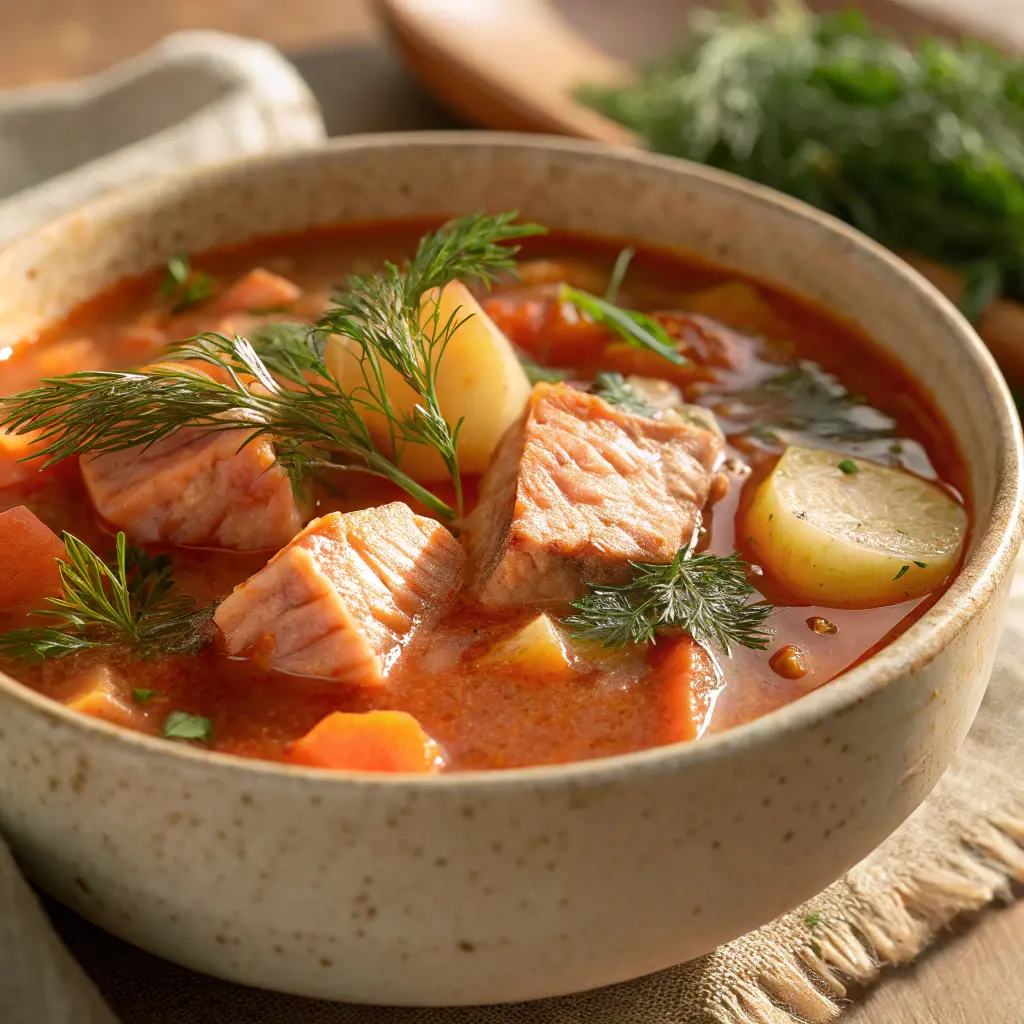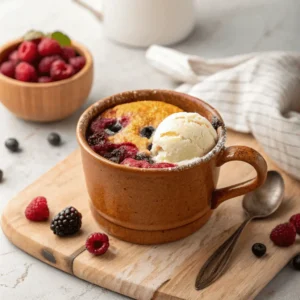Introduction to the Perfect Salmon Stew Recipe
What Makes a Good Salmon Stew Recipe?
There’s something incredibly satisfying about a warm bowl of stew—especially when it features rich, flaky salmon as the star. A well-crafted salmon stew recipe combines flavor, nutrition, and comfort in one dish. Whether you’re craving a quick family dinner or planning a healthy meal prep, salmon stew hits the mark every time.
The magic lies in balancing the flavors of tender salmon, hearty vegetables, aromatic spices, and a rich broth. A good stew should warm you from the inside out and feel like a hug in a bowl. With this article, you’ll learn how to craft the most flavorful salmon stew recipe, no matter your cooking level.
Looking for inspiration? Try our baked snapper recipe to expand your weekly menu.
Why Salmon Stew is a Great Choice for Healthy Comfort Food
If you’re aiming to eat healthy without sacrificing taste, salmon stew is your go-to. Salmon is packed with omega-3 fatty acids, protein, and essential vitamins, making it a superfood your body loves. Add in some root vegetables and a savory broth, and you’ve got a bowl full of nourishment.
Unlike creamy, calorie-heavy soups, a light salmon stew recipe brings warmth and satisfaction with fewer calories. Plus, it’s flexible. Whether you prefer a creamy base or a spicy broth, salmon adapts well to all variations.
Key Ingredients for a Flavorful Salmon Stew
Fresh vs. Canned Salmon: What’s Better for Stew?
Choosing the right salmon can make or break your stew. While both fresh and canned salmon work well, each brings a different vibe to your dish.
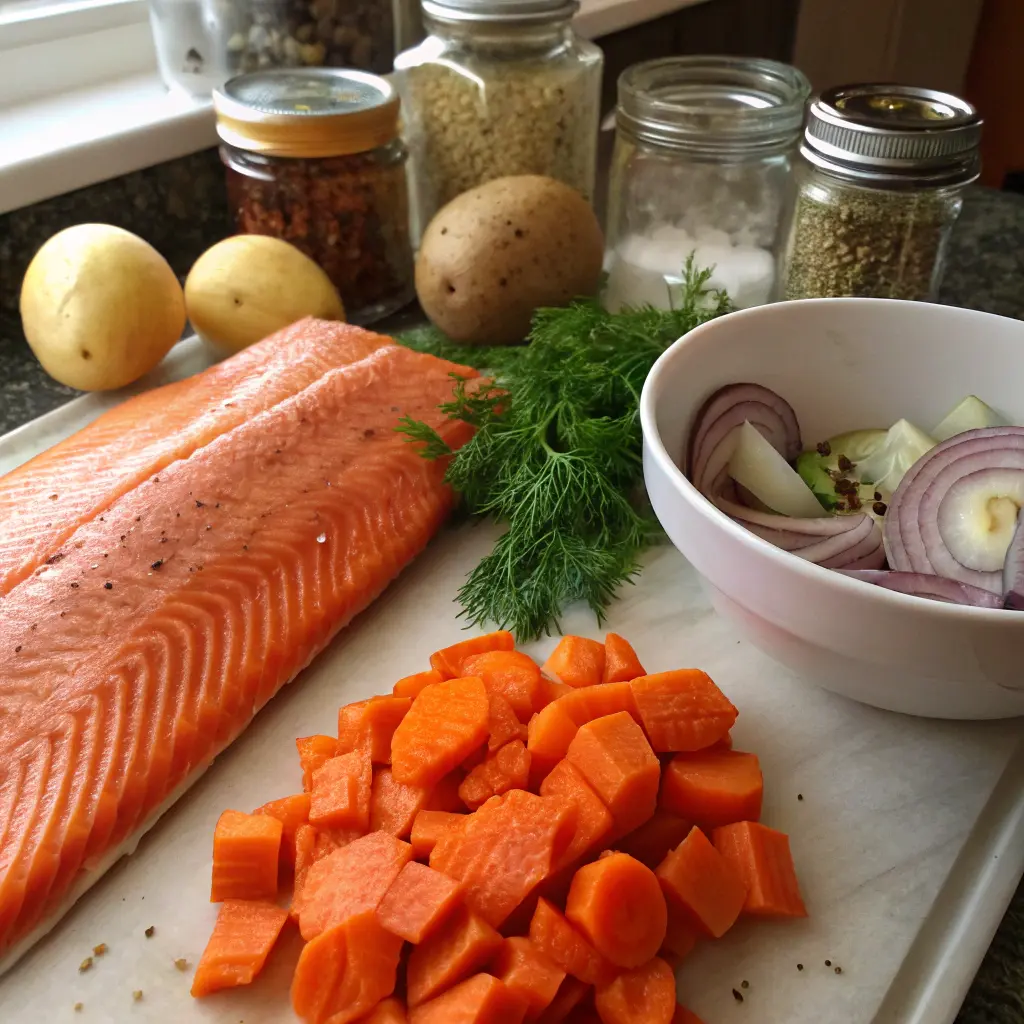
Fresh salmon delivers a rich, delicate flavor and flaky texture that elevates the stew’s overall taste. It’s perfect for when you want a gourmet feel. Opt for skinless, boneless fillets, preferably wild-caught, for the best nutritional value and clean taste.
Canned salmon, on the other hand, offers a budget-friendly, convenient option that still packs protein and omega-3s. It’s fully cooked and typically includes skin and bones, which are edible and rich in calcium. Just make sure to drain it well before adding it to your stew.
Here’s a quick comparison table to help you choose:
| Type of Salmon | Flavor Profile | Texture | Best Use Case |
|---|---|---|---|
| Fresh Salmon | Clean, delicate | Flaky, moist | Gourmet-style stews |
| Canned Salmon | Rich, briny | Softer, shredded | Quick weekday stews |
Essential Vegetables, Herbs, and Spices for Salmon Stew
The real depth in any salmon stew recipe comes from the supporting cast—vegetables, herbs, and spices that create that comforting, layered flavor.
Here are the must-have ingredients for a balanced stew:
- Aromatics: onion, garlic, leeks, and celery form the base for the stew’s savory backbone. Sauté these for maximum flavor.
- Root Vegetables: Potatoes, carrots, and parsnips add heartiness and natural sweetness.
- Tomatoes: Fresh diced tomatoes or tomato paste bring acidity and richness to the broth.
- Greens: Kale or spinach adds color, nutrients, and texture.
- Herbs: Thyme, dill, parsley, and bay leaves are perfect for enhancing the seafood essence.
- Spices: paprika, black pepper, crushed red pepper flakes (for heat), and a dash of turmeric or smoked paprika to deepen the flavor.
Here’s a spice pairing tip:
Paprika + Dill + Bay Leaves = A balanced aroma that complements the salmon without overpowering it.
Pro tip: Always use fresh herbs at the end of cooking and dried herbs at the beginning. This helps layer the flavors naturally as the stew simmers.
Step-by-Step Instructions for the Best Salmon Stew Recipe
Preparing the Salmon: Tips for Optimal Flavor and Texture
Before you start simmering your stew, you’ve got to get your salmon prep just right. Whether you’re using fresh fillets or canned chunks, how you handle the fish makes a big difference in both taste and texture.
If you’re using fresh salmon:
- Remove the skin if you prefer a cleaner, less oily taste.
- Cut into medium-sized chunks—about 1.5 inches. This size prevents overcooking and keeps the salmon moist.
- Season it lightly with salt, black pepper, and lemon juice beforehand for added depth.
- You can even lightly sear the salmon in olive oil before adding it to the stew. This locks in flavor and gives your stew a slightly smoky edge.
Using canned salmon instead?
- Drain well and remove excess bones or skin if desired.
- Add it toward the end of cooking, since it’s already cooked and just needs warming through.
Cooking the Stew: Simmering Techniques and Timing
Once your ingredients are prepped, it’s time to bring your salmon stew recipe to life. Follow these easy steps for a stew that’s rich, savory, and soul-soothing:
Step 1: Build Your Flavor Base
- Heat 2 tablespoons olive oil in a large pot over medium heat.
- Sauté chopped onions, garlic, leeks, and celery until soft and fragrant (about 5–6 minutes).
- Add diced carrots and potatoes, and cook for another 3 minutes.
Step 2: Layer the Flavors
- Stir in tomato paste or crushed tomatoes, and let it cook for 2 minutes to caramelize.
- Sprinkle in your dried herbs and spices (thyme, paprika, turmeric, bay leaves).
- Pour in 4-5 cups of low-sodium fish broth or vegetable stock. Stir well.
Step 3: Simmer to Perfection
- Bring the mixture to a gentle boil, then reduce heat to low.
- Cover and simmer for 15-20 minutes, or until vegetables are tender.
Step 4: Add the Salmon
- Gently stir in the salmon chunks.
- If using fresh salmon: simmer for 8–10 minutes or until the fish flakes easily.
- If using canned salmon, add in the last 5 minutes to avoid overcooking.
Step 5: Finishing Touches
- Stir in chopped spinach or kale just before turning off the heat.
- Adjust seasoning—add salt, pepper, or a squeeze of lemon to brighten the flavor.
- Top with fresh dill or parsley for a fresh herbal finish.
And there you have it—a wholesome salmon stew recipe that’s easy to make, packed with flavor, and perfect for both weeknights and weekends.
Creative Variations of the Classic Salmon Stew
Spicy Salmon Stew with Coconut Milk
Want to give your salmon stew a bold, exotic twist? Try a spicy salmon stew recipe with coconut milk. This variation blends creamy richness with a subtle heat, transforming a simple stew into a vibrant, flavor-packed meal.
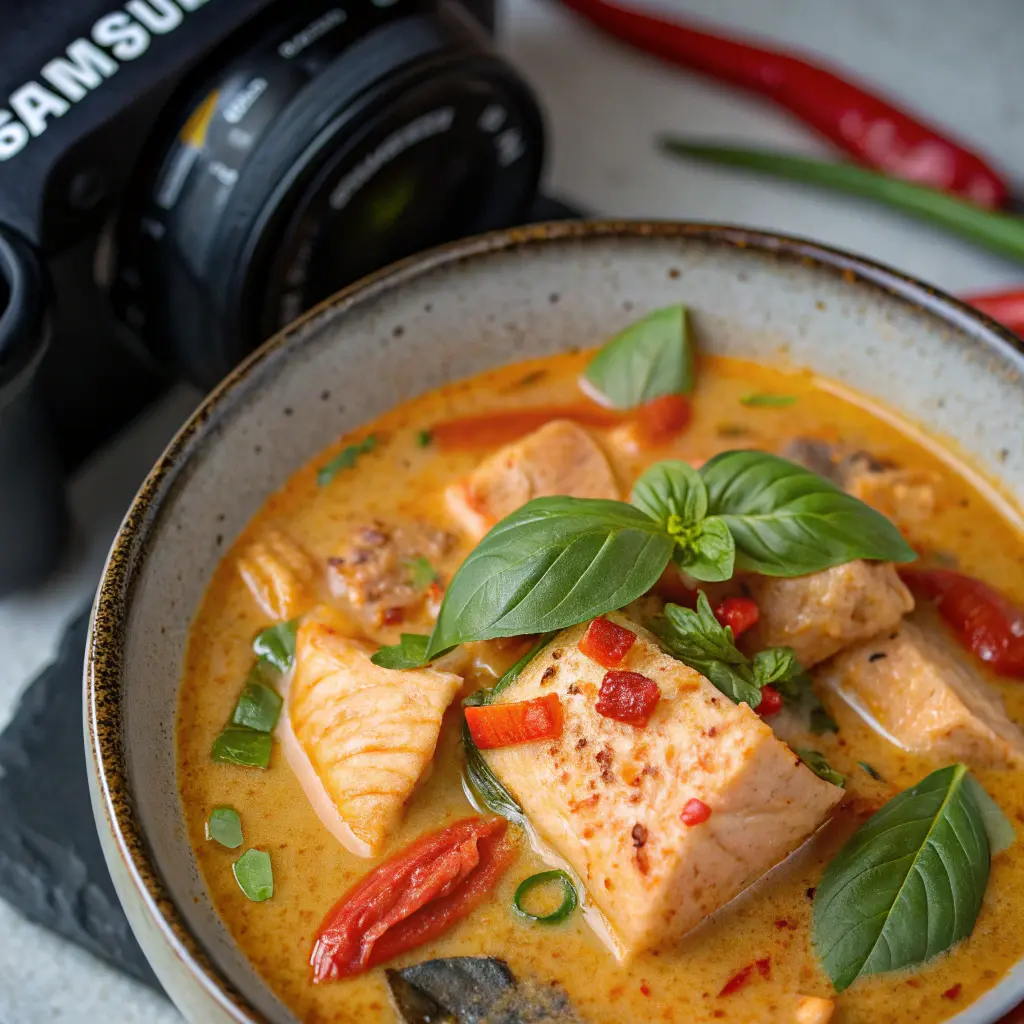
Here’s how to do it:
Key Ingredients to Add:
- 1 can (13.5 oz) of full-fat coconut milk
- 1 tsp curry powder or red curry paste
- ½ tsp crushed red pepper flakes
- 1 tsp ginger paste or grated fresh ginger
- Optional: sliced chili peppers for an extra kick
How to Modify the Original Recipe:
- After sautéing your aromatics, add ginger and curry powder before pouring in broth.
- Replace half of the broth with coconut milk.
- Add your salmon chunks after the stew has thickened slightly.
- Finish with fresh cilantro or Thai basil for a citrusy herbal note.
Flavor Tip: The coconut milk balances the heat perfectly, making this a great option for spice lovers who still want that creamy comfort food feel.
Creamy Salmon Chowder Variation: A Richer Alternative
If you’re in the mood for something more indulgent, turning your stew into a creamy salmon chowder is a no-fail idea. This version leans heavier on dairy, giving you a thick, velvety bowl of comfort that rivals restaurant-quality chowders.
What You’ll Need:
- 1 cup heavy cream or half-and-half
- 2 tbsp all-purpose flour or cornstarch (for thickening)
- 1 cup sweet corn kernels (optional but adds sweetness)
- ½ cup chopped bacon (for smoky undertones)
Preparation Tips:
- After sautéing vegetables, sprinkle flour over them and stir for 2–3 minutes to create a roux.
- Add broth gradually, stirring constantly to avoid lumps.
- Stir in cream after the stew base has simmered and thickened.
- Add salmon last, then finish with corn and bacon.
Flavor Tip: This version works well with crusty sourdough bread or garlic herb biscuits on the side.
Nutritional Benefits of Salmon Stew Recipe
Why Salmon is a Superfood
Salmon isn’t just delicious—it’s one of the most nutrient-rich proteins you can add to your diet. Whether you’re using fresh or canned salmon in your stew, you’re serving up a powerhouse of health benefits in every bowl.
Here’s what makes salmon a true superfood:
| Nutrient | Benefit |
|---|---|
| Omega-3 Fatty Acids | Supports heart health, reduces inflammation, improves brain function |
| High-Quality Protein | Promotes muscle repair, boosts metabolism, and keeps you full longer |
| Vitamin D | Essential for bone health and immune function |
| B Vitamins (B6, B12, Niacin) | Improves energy levels and supports nervous system health |
| Selenium | Acts as a powerful antioxidant and supports thyroid function |
A bowl of salmon stew recipe can easily provide 30-35 grams of protein, making it ideal for anyone following a high-protein or low-carb eating plan.
Health Benefits of Ingredients in Salmon Stew
The good news? It’s not just the salmon doing the heavy lifting—every ingredient in a salmon stew has something special to offer.
Let’s break it down:
- Root Vegetables (carrots, potatoes, parsnips)
Loaded with fiber, beta carotene, and slow-digesting carbs that support digestion and stabilize blood sugar. - Tomatoes
Rich in lycopene, an antioxidant linked to reduced risk of heart disease and certain cancers. - Leafy Greens (kale or spinach)
Excellent sources of iron, calcium, and vitamin K—all key players in maintaining strong bones and healthy blood flow. - Garlic and Onions
Natural immune boosters that help fight off colds, lower blood pressure, and support gut health. - Spices (turmeric, paprika, black pepper)
Anti-inflammatory compounds that enhance both flavor and wellness. - Olive Oil
A healthy fat that supports heart health and helps your body absorb fat-soluble vitamins.
So when you’re enjoying a steaming bowl of salmon stew, you’re not just indulging—you’re investing in your health, one spoonful at a time.
What to Serve with Salmon Stew for a Healthy Meal
Best Side Dishes: From Grains to Greens
Pairing your salmon stew recipe with the right sides not only rounds out the meal but also adds texture, flavor, and even more nutritional value. Whether you prefer something hearty or light, here are some perfect companions for your stew.
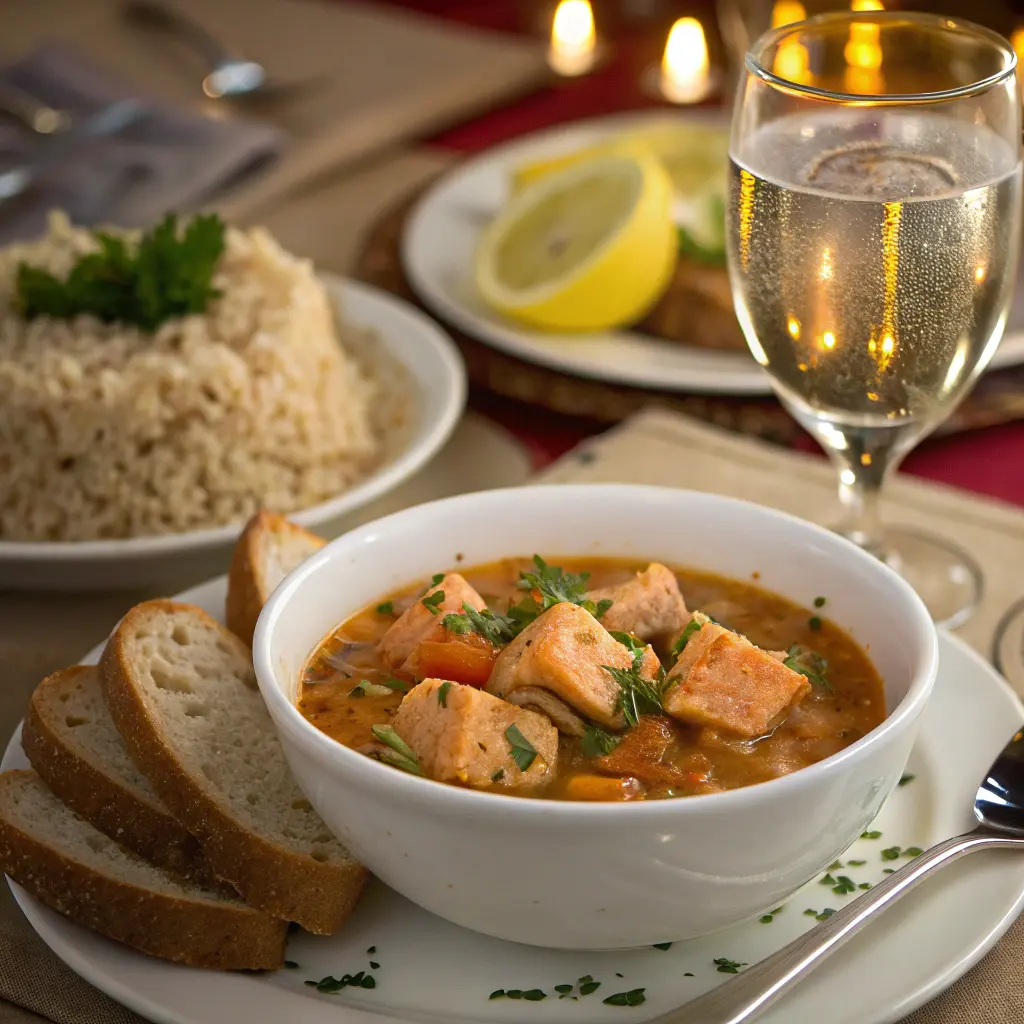
1. Whole Grains
Whole grains provide fiber and complex carbs, helping balance the protein-rich stew:
- Brown rice – A nutty, fiber-filled grain that absorbs the stew’s flavors beautifully.
- Quinoa – High in protein and gluten-free, quinoa adds a slightly earthy note.
- Barley – A chewy, hearty grain that adds a rustic feel to any seafood dish.
2. Light Salads
For freshness and crunch, pair your salmon stew recipe with a crisp salad:
- Cucumber and dill salad – Bright and herbaceous, it complements salmon’s richness.
- Arugula and citrus salad – Peppery greens with orange or grapefruit slices cleanse the palate.
- Spinach and feta salad – Adds a Mediterranean touch with salty, creamy notes.
3. Bread and Crackers
Dipping something into your stew is half the fun. Try:
- Whole grain baguette – Perfect for sopping up the savory broth.
- Cornbread – Slightly sweet, soft, and fantastic with spicy versions of salmon stew.
- Multigrain crackers – A crunchy, healthier alternative for texture contrast.
Perfect Beverages and Bread Pairings
No meal is complete without the right beverage—and your salmon stew recipe deserves a thoughtful pairing.
Here are some ideas:
| Beverage | Why It Works |
|---|---|
| Herbal tea (mint, chamomile) | Soothing, light, and complements delicate seafood flavors |
| Sparkling water with lemon | Refreshing and helps cleanse the palate |
| White wine (Sauvignon Blanc or Pinot Grigio) | Crisp acidity cuts through the stew’s richness |
Bonus Tip: Serve your salmon stew in shallow bowls with toasted bread on the side for a cozy bistro-style presentation.
Common Questions About Salmon Stew Recipe
Can salmon be stewed?
Absolutely—salmon can be stewed, and it’s one of the most delicious ways to enjoy this nutrient-rich fish. Unlike grilling or baking, stewing salmon gently simmers it in a flavorful broth, keeping it tender and moist. The slow cooking process allows the fish to soak up the rich flavors of vegetables, herbs, and spices, creating a wholesome dish that’s perfect for any season.
Whether you’re using fresh fillets or canned salmon, it holds up well in stews and makes for a comforting, protein-packed meal. Try it in a light tomato-based broth or a creamy chowder-style base for different flavor profiles.
What is the most flavorful way to cook salmon?
While there are many ways to cook salmon, stewing is one of the most flavorful methods, especially when combined with a robust broth and aromatic spices. Stewing allows the salmon to absorb flavors from garlic, onions, herbs like thyme and dill, and spices like paprika and turmeric.
For extra depth, some cooks choose to lightly sear the salmon before adding it to the stew. This caramelizes the surface and adds an extra layer of umami-rich flavor. Using coconut milk or bone broth as a stew base also enhances richness and complexity.
What to serve with salmon stew healthy?
If you’re wondering what to serve with salmon stew for a healthy meal, you’ve got plenty of delicious and nutritious options:
- Brown rice or quinoa for a fiber boost
- Mixed greens or arugula salad for freshness
- Roasted vegetables for added vitamins and texture
- Whole grain bread for a satisfying, hearty side
Pairing your stew with whole foods keeps the meal balanced, energizing, and light enough for any dietary lifestyle.
Is there such a thing as salmon chowder?
Yes! A salmon chowder is simply a creamier version of a salmon stew. While both dishes are hearty and warming, chowders typically include milk or cream, a thickening agent like flour, and often extras like sweet corn or bacon.
If you’re craving a richer, more indulgent variation of your traditional salmon stew, a chowder is the way to go. It’s a popular comfort food during colder months and works well as a standalone meal with crusty bread on the side.
What’s the difference between stew and chowder?
Though often used interchangeably, stew and chowder have distinct differences:
- Stew: A slow-cooked dish with broth-based liquid, often tomato or stock-based. It’s typically lighter and less creamy.
- Chowder: A thick, creamy soup made with milk or cream, sometimes thickened with flour or starch. Chowders are richer and heavier in texture.
In simple terms, if your dish is brothy and herb-forward, it’s a stew. If it’s thick and creamy, it leans into chowder territory.
What type of soup pairs well with salmon?
Looking for a soup pairing alongside salmon-based dishes? Here are a few light soups that complement salmon without overpowering it:
- Lemon orzo soup – bright, citrusy, and great before a stew
- Miso soup – adds umami and pairs well with seafood
- Cold cucumber soup – a fresh contrast to a warm salmon stew
Still, the salmon stew recipe often stands strong as the star of the table—it’s filling, balanced, and doesn’t always need a starter.
Storage, Reheating & Make-Ahead Tips
How to Store and Reheat Salmon Stew Without Losing Flavor
One of the best things about a salmon stew recipe is that it stores incredibly well—and might even taste better the next day as the flavors continue to develop.
Refrigerator Storage:
- Allow the stew to cool to room temperature before storing.
- Transfer to an airtight container.
- Store in the fridge for up to 3–4 days.
- Reheat gently on the stovetop over medium-low heat to preserve texture and flavor.
Microwave Reheating Tip:
- Use a microwave-safe bowl.
- Cover loosely to prevent splatter.
- Heat in 60-second intervals, stirring between each round until warmed through.
Pro Tip: Reheat only the portion you’ll eat. Repeated reheating can dry out the salmon and break down the veggies.
Freezing Tips: Preserve Your Stew for Later
Got extra stew and don’t want to waste it? No problem—salmon stew freezes beautifully with just a few precautions.
How to Freeze:
- Use freezer-safe containers or heavy-duty zip-top bags.
- Leave about an inch of space at the top for expansion.
- Label with the date for easy tracking.
Freezer Shelf Life:
- Best consumed within 2 months for optimal flavor and texture.
Thawing & Reheating:
- Thaw overnight in the fridge.
- Reheat slowly on the stovetop to prevent overcooking the salmon.
- Avoid reheating frozen stew directly in the microwave—it can lead to uneven texture.
Important Note: If your stew contains cream or milk (like a chowder variation), the texture may separate after freezing. In that case, stir in a splash of fresh cream after reheating to restore the richness.
Final Thoughts and Serving Inspiration
Serving Tips and Presentation Ideas
A hearty stew deserves a beautiful presentation—because let’s be honest, we eat with our eyes first. Once you’ve perfected your salmon stew recipe, take it to the next level with simple plating touches and thoughtful accompaniments.
Here are a few easy yet effective ways to elevate your dish:
- Serve in rustic ceramic bowls — They hold heat better and give a cozy, home-cooked vibe.
- Top each bowl with a sprig of fresh dill or parsley — Adds a pop of color and a burst of freshness.
- Drizzle a swirl of olive oil or a splash of cream on top — A small detail that enhances mouthfeel and visual appeal.
- Add a lemon wedge on the side — A squeeze of citrus right before eating brightens the whole dish.
Pair it with a slice of crusty whole-grain bread and a light salad, and you’ve got a meal that’s visually stunning, nutritionally balanced, and downright satisfying.
A Quick Recap of the Best Salmon Stew Recipe
Whether you’re a seasoned home chef or a beginner in the kitchen, this salmon stew recipe is easy to master and endlessly adaptable. You’ve learned how to:
- Choose the best type of salmon (fresh or canned)
- Build layers of flavor with herbs, spices, and hearty vegetables
- Create delicious variations like spicy coconut stew and creamy salmon chowder
- Pair your stew with healthy sides and drinks
- Store, reheat, and even freeze your leftovers the right way
This isn’t just another seafood recipe—it’s a wholesome comfort dish that fits any lifestyle, from heart-healthy eating to low-carb goals.
So, next time you’re wondering what to make for dinner, turn to this salmon stew recipe. It’s nourishing, flavorful, and always a crowd-pleaser.
FAQs
Can salmon be stewed?
Yes, salmon can be stewed. It’s one of the most flavorful and nutritious ways to cook this popular fish. Whether you’re using fresh or canned salmon, stewing allows the fish to soak up the bold flavors from the broth, herbs, and spices. A well-prepared salmon stew recipe keeps the fish moist and tender while infusing the dish with rich, savory goodness.
What is the most flavorful way to cook salmon?
The most flavorful way to cook salmon depends on the dish you’re making, but stewing salmon in a broth with spices and herbs is an excellent method. It gently cooks the fish, locking in moisture while allowing it to absorb layers of flavor from ingredients like paprika, garlic, dill, and thyme. Lightly searing the salmon before stewing can also enhance the flavor with a caramelized edge.
What to serve with salmon stew healthy?
For a balanced and healthy meal, pair your salmon stew recipe with nutritious sides like:
Steamed brown rice or quinoa
Light mixed greens salad with vinaigrette
Roasted root vegetables
Whole grain bread or crackers These sides complement the stew’s flavors without overpowering it, creating a complete and satisfying dish.
Is there such a thing as salmon chowder?
Yes, salmon chowder is a variation of salmon stew that features a creamier texture and richer flavor. Typically made with milk or cream, and often thickened with flour or starch, salmon chowder also includes ingredients like sweet corn, bacon, or potatoes. It’s a popular comfort food, especially in cooler weather, and offers a heartier twist on the traditional salmon stew recipe.
What’s the difference between stew and chowder?
The main difference lies in texture and ingredients:
Stew: Usually broth-based, lighter, and features a blend of vegetables and proteins simmered.
Chowder: Thicker, cream-based, often include milk, butter, or flour for richness. So, while both can include salmon, a salmon stew tends to be lighter and more brothy, while salmon chowder is creamier and heavier.
What type of soup pairs well with salmon?
If you want to serve soup as a starter before your main salmon stew recipe, go for something light and palate-refreshing:
Lemon orzo soup
Miso soup with tofu and scallions
Cold cucumber soup These options are mild enough not to compete with the rich flavors of salmon stew and make a great pairing for a multi-course meal.

